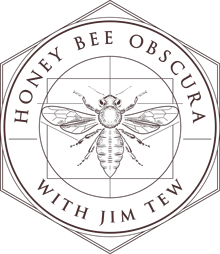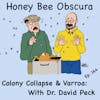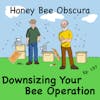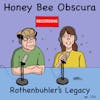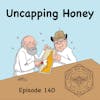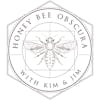Observing Queen Anomalies with Anne Frey

In this intriguing episode, Jim Tew and Anne Frey delve into the unexpected and often perplexing world of queen bee behavior and physiology that diverges from the norm. This episode explores the rare but fascinating occurrences that beekeepers might...
In this intriguing episode, Jim Tew and Anne Frey delve into the unexpected and often perplexing world of queen bee behavior and physiology that diverges from the norm. This episode explores the rare but fascinating occurrences that beekeepers might encounter with their queens, ranging from fainting queens during marking to queens with anatomical abnormalities. The hosts share their personal experiences and the lessons learned from handling queens that don't always follow the script, highlighting the importance of patience and observation in these situations.
Listeners will be captivated by stories of queens that momentarily 'faint' when handled for marking, a phenomenon that both hosts have witnessed firsthand. The discussion also covers how physical abnormalities, such as missing parts of a leg, can appear in queens yet not always affect their performance in laying eggs and leading the hive. Through these anecdotes, the episode underscores the unpredictable nature of beekeeping and the necessity for beekeepers to adapt to the unique challenges each hive can present.
Whether you're a seasoned beekeeper or just starting out, "Queen Anomalies" offers a deep dive into the less-discussed aspects of queen bee management. This episode encourages beekeepers to remain curious, adaptable, and compassionate towards their hives, even when faced with the most peculiar queen behavior and conditions.
Listen today!
______________________
Thanks to Betterbee for sponsoring today's episode. Betterbee’s mission is to support every beekeeper with excellent customer service, continued education and quality equipment. From their colorful and informative catalog to their support of beekeeper educational activities, including this podcast series, Betterbee truly is Beekeepers Serving Beekeepers. See for yourself at www.betterbee.com
______________________
Honey Bee Obscura is brought to you by Growing Planet Media, LLC, the home of Beekeeping Today Podcast.
Music: Heart & Soul by Gyom, All We Know by Midway Music; Christmas Avenue by Immersive Music; original guitar music by Jeffrey Ott
Cartoons by: John Martin (Beezwax Comics)
Copyright © 2024 by Growing Planet Media, LLC

Episode 172 – Observing Queen Anomalies with Anne Frey
[music]
Jim Tew: Listeners, in a perfect world, queens are always great. Do a good job producing eggs. Everything rolls along nicely. They produce gentle brood. In the real world, we discussed some of the things and other episodes that go wrong, but there can be some real anomalies and real things that just don't work the way you think they would and there's nothing in the book that's going to help you get through it. You're going to be on your own. I'm Jim Tew from Honey Bee Obscura.
Anne Frey: I'm Anne Frey from Betterbee.
Jim: I've asked Anne to come in and lets talk about some of the odd things that have happened to queens that we've had to deal with on the run or, Anne, some of the odd things that we did to queens that caused them foment and disconsternation.
Anne: And discombobulation.
Introduction: Welcome to Honey Bee Obscura, brought to you by Growing Planet Media, the producers of the Beekeeping Today Podcast. Join Jim Tew, your guide through the complexities, the beauty, the fun, and the challenges of managing honeybees. Jim hosts fun and interesting guests who take a deep dive into the intricate world of honeybees. Whether you're a seasoned beekeeper or just getting started, get ready for some plain talk that'll delve into all things honeybees.
Jim: Okay, Anne, give me some of those.
Anne: Oh, you know, there could be like, the queen that fainted while you were marking her, or the queen that got marked badly or squeezed when you marked her. Marking seems to be important to me and to many people, but it has to be done very carefully. What else could happen, Jim?
Jim: I want to go back to that fainting thing. You just touched that and kept right on going. I've had that happen a few times.
Anne: It's a thing.
Jim: But it's a puzzlement and until it happened to me, I thought it wasn't a real thing. Honestly, I thought that was just an overexcited, hyperventilated beekeeper. Until it happens to you. My story, really briefly, is that I picked her up, I had her in my hand. I was gentle, I was professional, and she was suddenly dead. You just stand there completely stultified. There's no blood and gut. I didn't crush her. How did this insect die with me being so careful and so gentle?
As I was having the thought, as I was completely flummoxed, I saw a little movement, a little quiver, and she had these odd-shaped leg things about her, like she was roadkill or something and she began to recover, and in just a few minutes, she was up and seemed to be okay. I gently put her back on the frame and call that one weird story in my repertoire.
Anne: When you say odd legs like roadkill, do you mean like she was spread-eagled and stiff?
Jim: Yes, she was kind of rigid.
Anne: Yes. That's the same way I've seen every time I've seen a fainted queen. I'm glad that you waited and thought about it. I have heard terrible stories about people that were just like, "Oh, darn it, I killed her," and they're just like, "Well," and they flick her in the woods.
[crosstalk]
Jim: Oh, no, I haven't.
Anne: It's like she was still alive. I've only seen it five times myself, and every time except one, in which case, she remained fainted and we checked her the next day and she was dead. We had her under a mesh queen introduction cage so we could be sure to find her that time when we came back. The other times she woke up within five minutes in the same exact pattern like you described. A little twitching and the slow recovery, and then just walking.
Jim: I'm sitting here thinking while you talk. I can't think of any science that has been able to narcosize a queen or CO2 or a general electrical shock. I don't know of any way to duplicate this behavior. Listeners, I want to be sure you know the word we're using. These queens appear to have fainted.
Anne: Yes, we call it fainting. Yes.
Jim: I don't know of any technical work that's been done on exactly what's happening to that queen. The overload. Sensory overload. What is it? I don't know.
Anne: I think you're right. I think that's what it is. Because every time I've heard a person say it happened to them, and every time I've seen it, it's either me or one of my helpers was handling the queen. We frequently just hold the queen when we're marking her, and there's so many to do. It's definitely kind of a stress thing, I think. When goats faint, their legs get all stiff and they fall down and we need a goat scientist.
Jim: [chuckles] No, we don't.
Anne: No, we don't.
Jim: I'm not getting in the goat business. You will not lure me down that path. My brother is a goat man. Question that I know the answer to but I'll ask you, have you ever seen a queen faint that you weren't holding?
Anne: No.
Jim: I've never seen it. I've never seen a queen faint on a comb.
Anne: It's always when we're doing something with her in our hand, and we're good at it. We're good at it too. It's a rarity that they faint.
Jim: I'm going to leave it with the listeners. What's going on here? We have picked up a queen on rare occasions. I've only had it happen just three or four times in my entire life. Anne says she handles a lot more queens than I do, so she sees it more often, but the queen appears to pass out for a few minutes. I guess the take-home information from you and me is, before you freak out and toss that queen, give her a few minutes to see if she recovers. The thing I was going to do that day was, honestly, was photograph my queen. If she's dead, I'll make a few pictures of a queen. At least I'll get something out of this other than a queen that I killed.
Anne: I like it. I like it.
Anne: Yes, take a picture. Take a video. I think with these digital camera phones that we all have now it's so easy to take pictures.
Jim: What do you do when you find a queen that just has an anatomical aberration? Something's not right. What I'm specifically thinking of, I had a queen that lasted pretty much a season without the distal part of her center leg, she was pretty much gone. She had no tarsal claw. She just had a stub that she walked on there.
Anne: She walked fine?
Jim: Well, I couldn't really communicate with her to that great of extent, but she seemed to move around with just a stub.
Anne: Yes, I wonder.
Jim: I have no idea how it happened. I didn't do it.
Anne: I suppose she might have developed that way, but I know that the front legs are probably the most important because she's feeling around in the cell when she's checking to see if it's occupied, and she's putting her antennae in, and she's sniffing and smelling with all her senses. I'm not sure really well if those middle legs are crucial. Interesting. Don't know how that happened though. Maybe the bees bit it through the screen of the cage when she was on the way or she was in the hive right after she was introduced.
Jim: We can make up any number of scenarios.
Anne: Oh, yes, we can go on all day.
Jim: She was damaged when they caught her or when she was caged, but the thing that I was curious about is I paid for her.
Anne: You do.
Jim: This is my package queen. Am I supposed to take her run and run right back up there and say, "I've got a defective queen," but by the time you do all that, she's already introduced, she's already laying, she's got a brood pattern. I think that my die is cast there and I'm just going to stay with this queen, but she went through the better part of a season. She was not replaced right away.
Anne: If she's laying well and you like her pattern, then you know, her speed of laying is fine and she's laying worker eggs. What does it matter? I would say. I have seen queens when they got older, though, and they didn't have anything visibly wrong with them, but they start to fall down off of the frame especially in an observation hive when it was really old queen and I was watching her incessantly. Some kind of nerve or muscle problem. Did I say muscle?
Jim: That's a good word.
Anne: It's like they're not gripping well, they're falling. They're not laying the eggs as consistent.
Jim: Yes, they clearly have muscle problems.
Anne: Must be. There's things. What else could have gone wrong with her? If she's missing her antennae or her rear legs, that's a big problem.
Jim: That's about all I could miss.
Anne: What about wings?
Jim: She was fine. The only thing that I could tell that was wrong with that queen was she had a peg leg on the left side of her body, center leg.
Anne: What if a queen was missing its wing or wings? You know how people used to clip the queens?
Jim: Let's take a break and come back and talk about that, because that's us mutilating the bees.
[music]
Betterbee: Are you an experienced beekeeper eager to try something new? Try making comb honey. Betterbee has you covered. Our range of ready-to-use systems, including hogg halfcomb and Ross rounds, makes it a breeze to get started. Or craft your own cut comb right in your existing frames. With Betterbee's expert guidance, you'll soon be harvesting delicious comb honey. Explore the options at betterbee.com/combhoney.
[music]
Jim: You're right. Years ago, I'm trying to think, when is the last time that I have seen any reference to clipping a queen? As a beekeeper decades ago, you bought little pairs of scissors from bee supply companies. I wonder if Betterbee has those clipping scissors in their catalog.
Anne: Maybe in an old catalog, yes. I don't know, maybe the '70s.
Jim: For clipping the very tip. You didn't cut the wing off, you just clipped the tip. You brought this up, you talk about it.
Anne: Well, I remember when I was new, and I was reading every book there was, they were actually all old books and I read that, and I never have done it. It sounded like a medieval torture sort of a system. I also kept reading more modern things like magazines, and I heard that it doesn't really do so much good, the hive, if it's going to swarm. Let's say people did this to stop their queen from disappearing during a swarm. I had read that it wasn't really going to do that because if they wanted to swarm they had further queen cells still cooking in the hives. It was going to swarm right after you-
[crosstalk]
Jim: Not with that queen, with a queen.
Anne: Right. I read all that and I just never decided to clip a queen. Have you done it?
Jim: I am sorry, I've clipped a few queens. I did not feel good about it. Let me tell you the reason was that my grandparents had a very traditional old style farm, and they had a chicken yard. Those birds at times would be able to fly across the fence. The farm people there working on the form would take those chickens and clip the end of their wings off, and the chickens couldn't fly over the yard fence then. That was the only association that I had with clipping a queen's wings.
Early on, I was convinced that that stopped swarming because the queen can't leave. She can't fly. I'll just stay here. Oh, no, she's going to try. All that was ever intended by this clipping process was to keep that swarm in a hivable location. Am I wrong about that? The Queen's going to be on the ground almost. It'll be an easy swarm to pick up.
Anne: She would probably be on a ground within a few feet, and you'd have a pancake swarm in the grass. They're not the easiest things to pickup, I'll tell you, but at least it didn't fly away 40 feet up in a tree.
Jim: Only the forewing, the main wing, and only the distal filth of it or so. She still wanted to fly, but you don't cut the wing off. If you cut the wing, and she's a mutant queen, and she is going to be superseded. Certainly not the lesser wing, too hard to get to. I found that to be a clumsy process. It's bad enough to hold a queen. It's better enough hold a queen, and try to spread that little wing out and then clip off the end of it and do it all with a degree of dexterity. I didn't do it much.
Anne: I'm glad that that's faded away, and we don't do that anymore.
Jim: How about mutated markings where you try to mark a queen and what you do is give her a three-coat paint job?
Anne: Well, I have seen that. I'm glad to say I've never done that, but it mostly is a situation where the person didn't check out their pen well enough before they started. Because everybody's careful when they mark the queen because they're worried about her, but if they didn't check that pen, and it's just ready to go explore, it's going to go on her. Yes, if it dribbles right across her back and towards her tail, it's going to be in all those plates of her abdomen that are supposed to be movable, and she won't be able to curl.
If it is on the wings she will never be able fly away with a swarm, which is cruel, but I don't know. It's just like you don't want that anywhere except on her thorax.
Jim: Just on her thorax. While you were talking, I was thinking, if you got to screw-up, if you really got to make a mess, then get it on her abdomen. Because I don't want you to get it on her antennae or on her ocelli or on the head part of her. She's got too much mechanical operation in her head for us to paint over that.
Anne: And chemical. I think that the body itself is mechanically messed up if it's gotten drying paint across all of those abdominal portion--
Jim: I fell like I'm a fossil, but in my earliest days we used really fine camel hairbrushes. I forget the size of it, they were called camel-hair. I wonder if they were actually camelhair brushes.
Anne: Oh, it wasn't your camel?
Jim: No, that was not my camel, so I can't verify that with certainty. That was so easy. You paint, paint, paint. You don't just dab, you did paint, paint, paint. You're just looking for a reason to screw that up. At least as time passed, I was taught to use pretty much a matchstick and just take a dollop of paint on the end of that matchstick and then touch it to her thorax. That'd be enough of a dot. Then you got to hold that queen while she dries, you put her back down too soon, it smears, and everything we talked about has happened.
Anne: At least it's more controllable than a paint marking pen, which it is a liquid paint inside there, and if it was hot before you used it, or if you didn't test dot on something else, you might get quite a lot more than what would fit on the tip of a matchstick. People got to practice their technique.
Jim: That's an easy thing for you to casually say.
[crosstalk]
Anne: Oh, I don't in practice on queens. I mean practice on-
Jim: It's like practicing ski jumping. I mean, how?
Anne: No, no. Practice on your smoke or practice on the back of your hand.
Jim: Yes, or practice on poor long-suffering drones.
Anne: No.
Jim: How many drones have people marked, trying to learn to mark their queens?
Anne: It's always fun to enter a hive and find drones with marks, especially after a field day or something like that. That's when you see them, but it's a skill. I think it's really great to have marked queens and I love to be able to find the queen dependably and sell nukes that have marked queens in them for people, but it's a skill.
Jim: I like this topic. Since we've mentioned it, I'll let it cool for a few months or more. I'm going to come back and do a dedicated topic just on marking this queen.
Anne: Sounds good.
Jim: Listen, sometimes a queen can be small, not have a good personality, not be in a good mood most of the time, and do a really good job.
Anne: Yes, or she's runny.
Jim: Other times she can be a beautiful queen and not do a great job.
Anne: Yes, I've seen that. She thinks she is on vacation. She's walking around and she's waiting, and she is getting fed, but she's never laying an egg, and she's beautiful. She's just like she's on the beach.
Jim: Yes, she just never gets around to really doing the job she supposed to do.
Anne: Yes, laying eggs.
Jim: Even though I like to look at a nice queen, she's all pretty and either she's glossed black or bright yellow, whatever the case may be, and she's got a regal stature about her, and she calm on the comb. All those things are great, but it needs to be the quality of the brood that she's producing.
Anne: Exactly.
Jim: If she is doing that without those characteristics I just described, so be it. Sometimes one of these anomalies queens can have, is that they just don't get the job done, and by all accounts, appearance-wise, they should be knocking it dead.
Anne: Yes, and then what do you do? I've heard somebody, he says, "You give her the hive tool test when she's not satisfying you."
Jim: [chuckles]
Anne: Some people in the audience, they were like, "What's the hives tool tests?" He said, "Oh, I'm sorry, that's just my way of saying crush her with your hive tool."
Jim: Yes.
Anne: If that has to be done, if you don't have a satisfactory brood pattern or a beautiful brood pattern, there's no way to requeen a hive until that first queen is dead and gone, so I kill her quick.
Jim: I didn't want to finish on this note, but killing them quick, I guess killing them quickly is just the right way to go because there is no retirement home, there's no, "I'll put you over here. I'll put you in a cage." That's just a slow death.
Anne: Or I'll send you to a farm.
Jim: Yes. There is no farm.
Anne: No.
Jim: Once this queen is done, she's just done. I never enjoy doing it, but quick dirty. I'm always need photographs, so sometimes I'll keep her for a photograph, but ultimately she's going to the great hive in the sky.
Here's the deal, we talked about some of the odd things that can go wrong with queens. I had a queen that didn't start producing workers until about a week, about a weekend to her productivity. I was going to replace her. She was just producing drones and then something clicked, and she became a good queen from then on.
In the books, all queens are good, all queens are docile, and all queens are introduced correctly, and all queens begin laying in just a few days.
Anne: All queens read the book.
Jim: I think if they read the same book, everything's good. You and I both know it's an adventure out there, and you got a roll with whatever punch comes your way.
Anne: We're learning.
Jim: Finish us on a good note here on this whole what can go wrong with the queen that you weren't expecting discussion that we've just had.
Anne: I want to point out again, I think I've mentioned once or twice that these are rarities. Usually she is doing her job, and she's doing it great. It's just a lot of fun though to open up a hive and find this excellent brood pattern or stare at your observation hive, and watch her doing an egg, egg, egg, wait, get fed, retinue forms, egg, egg, egg.
Jim: Food in, egg out, food in, egg out.
Anne: That's how it happens. Yes, these things they're good to learn about, but they're rarities.
Jim: Well, that's what makes it spicy, though. Anne, I enjoyed talking with you, I always do.
Anne: Thanks, Jim, I like it too. This is fun.
Jim: Until we can chat again, I'm telling you bye. Listeners, bye to you too, and you tell them bye.
Anne: Bye, Jim. Bye, everybody. Thanks for coming.
[00:20:02] [END OF AUDIO]
New to Honey Bee Obscura Podcast?
Here are some great episodes to start with. Or, check out episodes by topic.







 In this intriguing episode, Jim Tew and Anne Frey delve into the unexpected and often perplexing world of queen bee behavior and physiology that diverges from the norm. This episode explores the rare but fascinating occurrences that beekeepers might encounter with their queens, ranging from fainting queens during marking to queens with anatomical abnormalities. The hosts share their personal experiences and the lessons learned from handling queens that don't always follow the script, highlighting the importance of patience and observation in these situations.
In this intriguing episode, Jim Tew and Anne Frey delve into the unexpected and often perplexing world of queen bee behavior and physiology that diverges from the norm. This episode explores the rare but fascinating occurrences that beekeepers might encounter with their queens, ranging from fainting queens during marking to queens with anatomical abnormalities. The hosts share their personal experiences and the lessons learned from handling queens that don't always follow the script, highlighting the importance of patience and observation in these situations.
